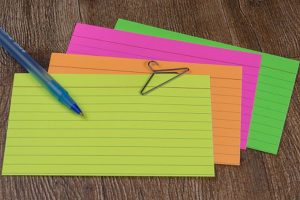Flashcards – A favorite student study tool. All those little pieces of paper can be a real boon to studying if you know how to use them effectively. That’s what I will write my paper about.

You’ve seen them in backpacks, on desks, tucked in pockets, and clutched in hands – those little pieces of paper with clues on one side and data on the other. Flashcards are a staple of every student’s tool kit, but not everyone is able to use them to their benefit. Whether they are designed to aid in language learning, the periodic table, dates in history, or quotes from Shakespeare, the strategic use of these simple devices can be tricky. Try some of these methods and see if they don’t make a positive difference in both memory and application.

KISS – Keep It Simple Student
Experts who write essays for students, advise don’t put too much on each flashcard. This is a basic mistake students make. Determine your primary goal – vocabulary, structure, conjugation, or word forms, and then create cards that meet only that goal. Trying to include everything will scatter your focus and reduce your ability to learn. As an example, for vocabulary, put the English translation as a cue on one side, and on the other write the word in the target language, along with the part of speech and perhaps a short phrase using the word in context.
Rubber Bands, String, or Metal Ring
Another element to remember is that your flashcards should fit your personal study style. You may be a traditionalist who loves to wrap those rubber bands around a big stack of French verbs, or Arabic roots. Snap! Others prefer to hole punch their cards and tie them together with a string. At some specialty stationers shops, you can find flash cards punched and held together with a metal ring. Whichever type you choose, don’t make the stacks too large. It is easier to feel successful when the body of words or sentences you have to conquer is less than an inch high.
Color Coding
Color coding of flash cards is a great help in the initial stages of learning or memorization. Those marked in red can be verbs, blue for nouns, yellow for adjectives, etc. However, do not color code the cards too large or permanently, since eventually you will need to know the designation of each word without the color hint. If you use an erasable color pencil to mark each card, then, when you are ready, you can erase or white out the color. Other ways to color code is by function, such as question words, colors, comparatives or superlatives, or to stipulate which words take a certain type of inflection or ending.
Partner Practice
According to the thesis paper writing service, there is anecdotal evidence that shows that studying with someone can improve scores by 10 – 30 percent. This has repeatedly proven true with my students despite their initial reluctance to partner with someone. Studying flashcards with someone can have the same positive results. There are many options. Students can either alternate, each using his or her own stack of cards and trying to give the correct response for the cue word, or trying to go through one set at a time, taking on every other word. Another method is to make it a quiz, wherein the winner buys a latte or gets a piece of chocolate. Be careful that you don’t OD on coffee or chocolate.
Success Pays Off
When you have proven your proficiency with a word or structure, take it out of the pack. Some people draw a line through the word and see how high that pile can get. Others use them to paper a door or wall as a very visual sign of success. One student kept them in a photo album and lined up the albums as she worked her way from beginner to advanced French speaker. I suggest you think of some means to celebrate every 25 or 50 cards. Learning is hard work and it deserves to be rewarded.
Next Entries
How to Turn Digital Images into a Photo Book
A Review of the Inconvenient Marriage of Charlotte Beck
Talking to Kids About Tropical Storms and Hurricanes